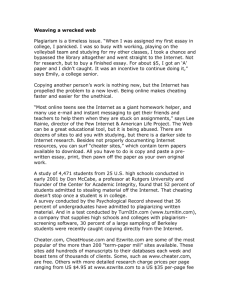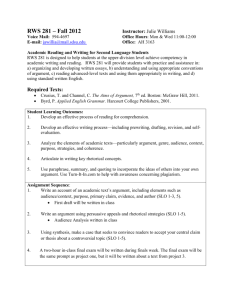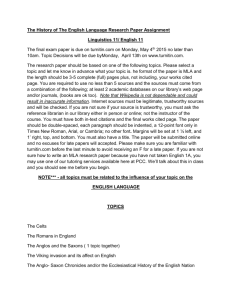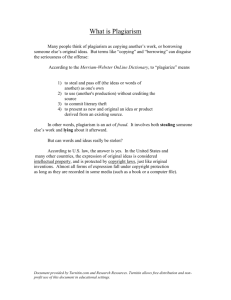To Stop Cheats, Colleges Learn Their Trickery
advertisement
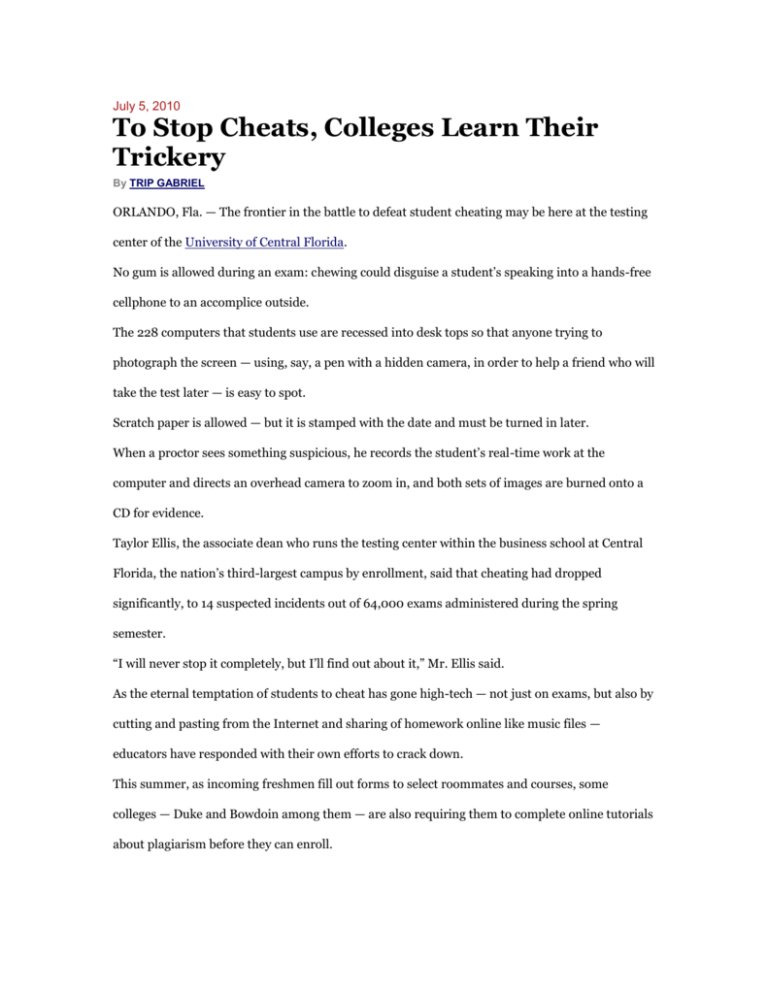
July 5, 2010 To Stop Cheats, Colleges Learn Their Trickery By TRIP GABRIEL ORLANDO, Fla. — The frontier in the battle to defeat student cheating may be here at the testing center of the University of Central Florida. No gum is allowed during an exam: chewing could disguise a student’s speaking into a hands-free cellphone to an accomplice outside. The 228 computers that students use are recessed into desk tops so that anyone trying to photograph the screen — using, say, a pen with a hidden camera, in order to help a friend who will take the test later — is easy to spot. Scratch paper is allowed — but it is stamped with the date and must be turned in later. When a proctor sees something suspicious, he records the student’s real-time work at the computer and directs an overhead camera to zoom in, and both sets of images are burned onto a CD for evidence. Taylor Ellis, the associate dean who runs the testing center within the business school at Central Florida, the nation’s third-largest campus by enrollment, said that cheating had dropped significantly, to 14 suspected incidents out of 64,000 exams administered during the spring semester. “I will never stop it completely, but I’ll find out about it,” Mr. Ellis said. As the eternal temptation of students to cheat has gone high-tech — not just on exams, but also by cutting and pasting from the Internet and sharing of homework online like music files — educators have responded with their own efforts to crack down. This summer, as incoming freshmen fill out forms to select roommates and courses, some colleges — Duke and Bowdoin among them — are also requiring them to complete online tutorials about plagiarism before they can enroll. Anti-plagiarism services requiring students to submit papers to be vetted for copying is a booming business. Fifty-five percent of colleges and universities now use such a service, according to the Campus Computing Survey. The best-known service, Turnitin.com, is engaged in an endless cat-and-mouse game with technologically savvy students who try to outsmart it. “The Turnitin algorithms are updated on an on-going basis,” the company warned last month in a blog post titled “Can Students ‘Trick’ Turnitin?” The extent of student cheating, difficult to measure precisely, appears widespread at colleges. In surveys of 14,000 undergraduates over the last four years, an average of 61 percent admitted to cheating on assignments and exams. The figure declined somewhat from 65 percent earlier in the decade, but the researcher who conducted the surveys, Donald L. McCabe, a business professor at Rutgers, doubts there is less of it. Instead, he suspects students no longer regard certain acts as cheating at all, for instance, cutting and pasting a few sentences at a time from the Internet. Andrew Daines, who graduated in May from Cornell, where he served on a board in the College of Arts and Sciences that hears cheating cases, said Internet plagiarism was so common that professors told him they had replaced written assignments with tests and in-class writing. Mr. Daines, a philosophy major, contributed to pages that Cornell added last month to its student Web site to bring attention to academic integrity. They include a link to a voluntary tutorial on avoiding plagiarism and a strongly worded admonition that “other generations may not have had as many temptations to cheat or plagiarize as yours,” and urging students to view this as a character test. Mr. Daines said he was especially disturbed by an epidemic of students’ copying homework. “The term ‘collaborative work’ has been taken to this unbelievable extreme where it means, because of the ease of e-mailing, one person looking at someone else who’s done the assignment,” he said. At M.I.T., David E. Pritchard, a physics professor, was able to accurately measure homework copying with software he had developed for another purpose — to allow students to complete sets of physics problems online. Some answered the questions so fast, “at first I thought we had some geniuses here at M.I.T.,” Dr. Pritchard said. Then he realized they were completing problems in less time than it took to read them and were copying the answers — mostly, it turned out, from email from friends who had already done the assignment. About 20 percent copied one-third or more of their homework, according to a study Dr. Pritchard and colleagues published this year. Students who copy homework find answers at sites like Course Hero, which is a kind of Napster of homework sharing, where students from more than 3,500 institutions upload papers, class notes and past exams. Another site, Cramster, specializes in solutions to textbook questions in science and engineering. It boasts answers from 77 physics textbooks — but not Dr. Pritchard’s popular “Mastering Physics,” an online tutorial, because his publisher, Pearson, searches the Web for solutions and requests they be taken down to protect its copyright. “You can use technology as well for detecting as for committing” cheating, Dr. Pritchard said. The most popular anti-cheating technology, Turnitin.com, says it is now used by 9,500 high schools and colleges. Students submit written assignments to be compared with billions of archived Web pages and millions of other student papers, before they are sent to instructors. The company says that schools using the service for several years experience a decline in plagiarism. Cheaters trying to outfox Turnitin have tried many tricks, some described in blogs and videos. One is to replace every “e” in plagiarized text with a foreign letter that looks like it, such as a Cyrillic “e,” meant to fool Turnitin’s scanners. Another is to use the Macros tool in Microsoft Word to hide copied text. Turnitin says neither scheme works. Some educators have rejected the service and other anti-cheating technologies on the grounds that they presume students are guilty, undermining the trust that instructors seek with students. Washington & Lee University, for example, concluded several years ago that Turnitin was inconsistent with the school’s honor code, “which starts from a basis of trusting our students,” said Dawn Watkins, vice president for student affairs. “Services like Turnitin.com give the implication that we are anticipating our students will cheat.” For similar reasons, some students at the University of Central Florida objected to the business school’s testing center with its eye-in-the-sky video in its early days, Dr. Ellis said. But recently during final exams after a summer semester, almost no students voiced such concerns. Rose Calixte, a senior, was told during an exam to turn her cap backward, a rule meant to prevent students from writing notes under the brim. Ms. Calixte disapproved of the fashion statement but didn’t knock the reason: “This is college. There is the possibility for people to cheat.” A first-year M.B.A. student, Ashley Haumann, said that when she was an undergraduate at the University of Florida, “everyone cheated” in her accounting class of 300 by comparing answers during quizzes. She preferred the highly monitored testing center because it “encourages you to be ready for the test because you can’t turn and ask, ‘What’d you get?’ ” For educators uncomfortable in the role of anti-cheating enforcer, an online tutorial in plagiarism may prove an elegantly simple technological fix. That was the finding of a study published by the National Bureau of Economic Research in January. Students at an unnamed selective college who completed a Web tutorial were shown to plagiarize two-thirds less than students who did not. (The study also found that plagiarism was concentrated among students with lower SAT scores.) The tutorial “had an outsize impact,” said Thomas S. Dee, a co-author, who is now an economist at the University of Virginia. “Many instructors don’t want to create this kind of adversarial environment with their students where there is a presumption of guilt,” Dr. Dee said. “Our results suggest a tutorial worked by educating students rather than by frightening them.” Only a handful of colleges currently require students to complete such a tutorial, which typically illustrates how to cite a source or even someone else’s ideas, followed by a quiz. The tutorial that Bowdoin uses was developed with its neighbor colleges Bates and Colby several years ago. Part of the reason it is required for enrollment, said Suzanne B. Lovett, a Bowdoin psychology professor whose specialty is cognitive development, is that Internet-age students see so many examples of text, music and images copied online without credit that they may not fully understand the idea of plagiarism. As for Central Florida’s testing center, one of its most recent cheating cases had nothing to do with the Internet, cellphones or anything tech. A heavily tattooed student was found with notes written on his arm. He had blended them into his body art.
